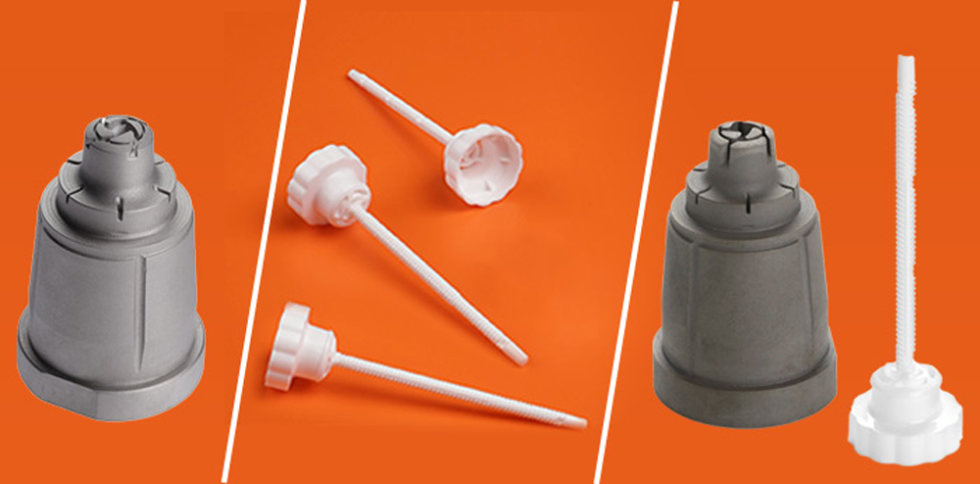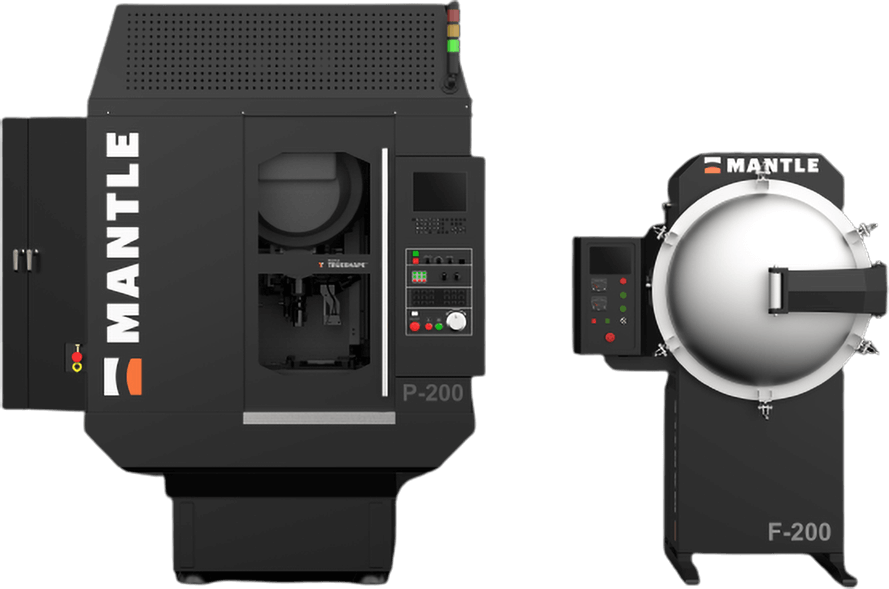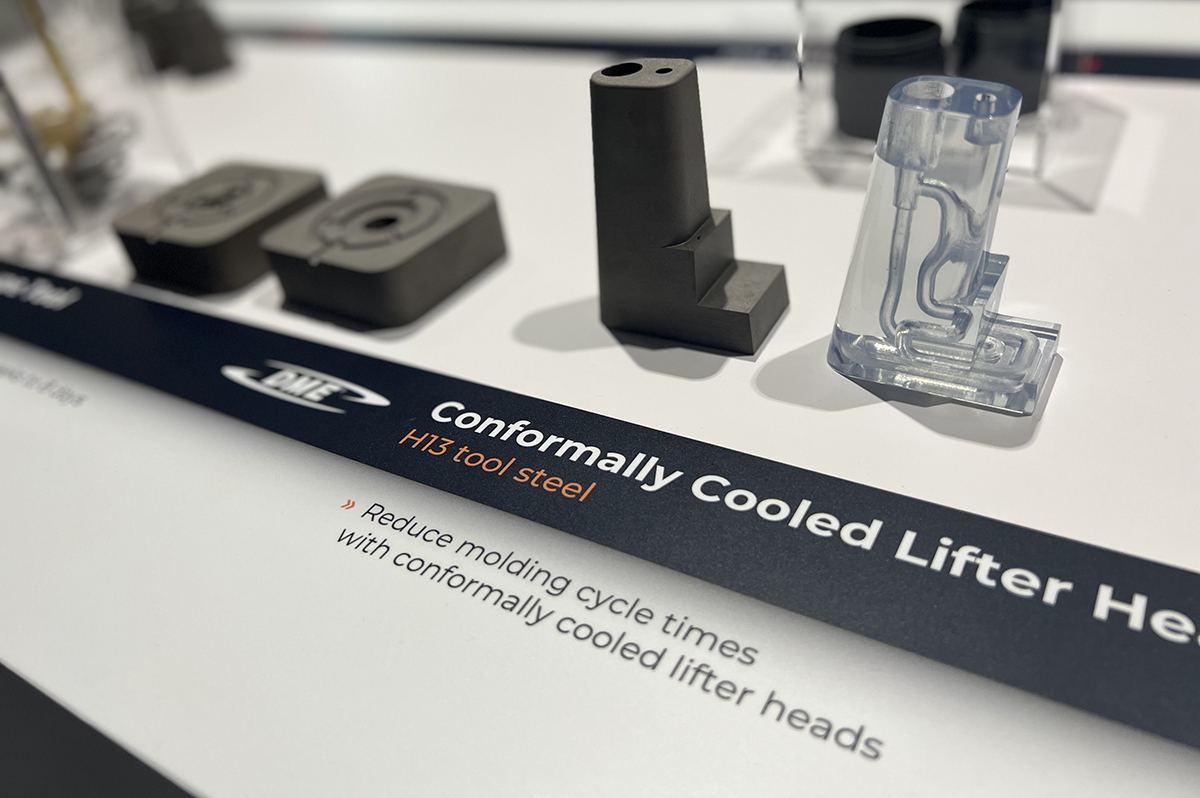After six years of development, Mantle has finally released its commercial metal 3D printing system, which combines bound metal extrusion with CNC milling to achieve results so far unreached by the rest of the binder jetting segment. What’s more interesting than the technology, however, is Mantle’s business model, as the Bay Area startup is targeting first and foremost the $45 billion market for injection molding tools. To learn more, we spoke to Mantle CEO Ted Sorom, as well as Chief Commercial Officer Paul DiLaura and Director of Marketing Ethan Rejto.
The P-200 3D Printer
Ahead of IMTS, Mantle announced the commercial release of its P-200 3D printer, designed around a reliable CNC platform outfitted with an extrusion head for metal pastes. With a build volume of 200mm x 200mm x 150mm, the machine first prints a layer that is heated to dry the paste, evaporating some of the binder material. After 10 layers or so have been printed, a high-speed CNC mill trims the part, resulting in higher accuracy and smoother surface finish. Because it is machining dried paste, rather than solid metal, the cutting process is significantly faster.
The green part is then placed in Mantle’s F-200 furnace, sintering them to near fully dense tool steel components. Due to the fact that some of the binder has already evaporated during the printing process, shrinkage during sintering is limited to below 10 percent, unlike traditional bound metal parts, which generally shrink around 20 percent. This makes it easier to predict the end result.
The use of CNC also enables “best-in-class surface finish” of 1-3µm Ra. Even pre-sintering, the printed objects are extremely smooth. This not only means improved accuracy, but also little to no post-processing.
So far, tool steels H13 and P2X (similar to P20) have been developed for Mantle’s TrueShape process. The future material road map features more tool steels because, as it stands, the startup is targeting the injection molding sector. By uniquely meeting the needs of precision tooling, the company is able to access the immense opportunity that lies in that sector.
Dental Tooling: the #1 3D Printing Application
Highlighting a part on display at IMTS, Rejto noted, “This part from Tessy Plastics molds this piece for a deodorant core. It has been going for 1.4 million cycles and counting. It’s still in production.” The team couldn’t tell me which deodorant companies were using the parts injection molded with Mantle-made tooling, except to say that they were name brand products that could be found in any drug store.

Mantle’s metal 3D printed insert and the deodorant parts molded with the Mantle insert. Image courtesy of Mantle.
That immediately made an impact on me. Typically, additive companies are targeting mass manufacturers, but because they shoot for 3D printing end parts, the throughput and cost savings just aren’t there to see the technology used for all that many items that I might find in my daily life. By applying AM to indirect manufacturing, however, there is a butterfly effect that is undeniable.
CEO Ted Sorom underscored this point, saying, “The largest application for 3D printing in the world today is a tooling application. Do you know what it is? Clear dental aligners, made with thermoforming.”
Companies like Invisalign have created an entire industry through the use of indirect manufacturing with 3D printing. By 3D printing a model of a patient’s the teeth the way the orthodontist prescribes, it’s possible to thermoform clear aligners using stable, biocompatible materials. While firms are developing materials for the end 3D printing of dental aligners, they have only begun to hit the market. In the meantime, thermoforming models are being printed at a rate of 200 million units annually.
Tooling: the $45B 3D Printing Application
Typically in the AM sector, machine salespeople are also application engineers and consultants. They don’t just try to unload a 3D printer onto a customer, but also have to co-develop a use case and aid the client in the design and production process. Mantle is trying a completely different approach.
The tools presented at IMTS all looked like traditional tools. There were no lattice structures or consolidated assemblies. Instead, they were just as solid and sturdy as tools made with CNC machining. They were tools that a customer could trust, that operated like anything they’ve had their hands on in the past.
To get 3D printing’s foot in the door of this legacy sector, which Sorom estimates to be worth $45 billion, Mantle isn’t trying to reinvent the wheel. The biggest difference between TrueShape tools and something made conventionally was that they were designed and manufactured in the course of a couple of weeks instead of several months and at half the cost.
Mantle doesn’t sell the geometric freedom of additive as a reason for adopting its technology. In many cases, the very mention of “conformal cooling,” which can speed up the heat dissipation of an injection molding tool, can make customers nervous. The fear of mold flow software is enough to send traditional manufacturers running for the door.
“We’re making sure that you can print a fully dense, solid piece of metal, because that’s what toolmakers are used to. The vast majority of the parts you see here [at Mantle’s IMTS booth] today are exactly like the engineer’s design. We’re just printing so much faster and at lower cost. For us, conformal cooling and new geometries are icing on the cake,” Sorom said. “Then, as you become educated, you can use this powerful capability to do conformal cooling and improve the power quality or the cycle times.”
Mantle’s strategy raised the possibility that other metal 3D printing companies highlight conformal cooling and other unique design possibilities to justify the extremely high cost for their machines. Typically, a powder bed fusion system can range well over half-a-million dollars. In contrast, the entire Mantle system, including the P-200 printer and F-200 furnace, is $350,000.
TrueShape 3D Printing in the Larger Market
When looking at the user landscape, there are several routes that Mantle could go and it is apparently pursuing all of them. Specifically, the firm is targeting toolmakers, injection molding providers, and vertically integrated businesses that have toolmaking and manufacturing performed in-house.
“We have worked with companies like L’Oreal and others on the OEM side, but, fundamentally, it always gets down to someone who’s making the tool,” DiLaura said. “It’s either a tool maker or a captive in-house group that’s doing tooling for them. We have found that folks in medical and other industries where they are vertically integrated, where they make their own tools and run the plastic production can get a lot of value out of what we do because they know how to speed up those cycle times. They capture more value. Not only is their tool faster, but their production faster and they get a better quality part.”
The TrueShape process may be complementary to other 3D printing technologies, including those directly targeting tooling, such as those from Addifab and Fortify. While Addifab’s Freeform Injection Molding is meant for temporary tooling for short run injection molding, Fortify’s technology is meant to produce longer-lasting molds using technical ceramic materials. These processes could potentially be used for bridge tooling or prototyping before a manufacturer turns to a final metal mold.
Regardless of how they stack up against one another, these firms could all aid in the reshoring of U.S. manufacturing. Sorom estimated that about $8 billion of tooling is made in the United States, while $26 billion is performed in Asia. Because the expertise to make tools has been exported overseas, it’s possible that new digital processes could reverse the process.
With students, designers and engineers in the U.S. focusing more on CAD than on traditional toolmaking, 3D printing with technologies like TrueShape could allow domestic production to be digitized. This would be particularly beneficial during supply chain crises the likes of which were exposed during the COVID-19 pandemic and the war in Ukraine.
“The time and effort it takes to get to a journeyman mold maker, someone that can make tools like this is four to five years and 8,000 to 10,000 hours. We actually enable not just speeding up the process, but a tool that literally you take the CAD file for this, put it into our system, load the machine, press the button, have dinner with your family, come back the next day and or the day after and you’ve got a part waiting for you. And that level of automation is what the industry needs to be able to be localized, to be able to bring it back from the States,” Sorom concluded.
Subscribe to Our Email Newsletter
Stay up-to-date on all the latest news from the 3D printing industry and receive information and offers from third party vendors.
You May Also Like
3D Printing Unpeeled: New Arkema Material for HP, Saddle and Macro MEMS
A new Arkema material for MJF is said to reduce costs per part by up to 25% and have an 85% reusability ratio. HP 3D HR PA 12 S has been...
3D Printing News Briefs, January 20, 2024: FDM, LPBF, Underwater 3D Printer, Racing, & More
We’re starting off with a process certification in today’s 3D Printing News Briefs, and then moving on to research about solute trapping, laser powder bed fusion, and then moving on...
3D Printing Webinar and Event Roundup: December 3, 2023
We’ve got plenty of events and webinars coming up for you this week! Quickparts is having a Manufacturing Roadshow, America Makes is holding a Member Town Hall, Stratafest makes two...
Formnext 2023 Day Three: Slam Dunk
I’m high—high on trade show. I’ve met numerous new faces and reconnected with old friends, creating an absolutely wonderful atmosphere. The excitement is palpable over several emerging developments. The high...


































